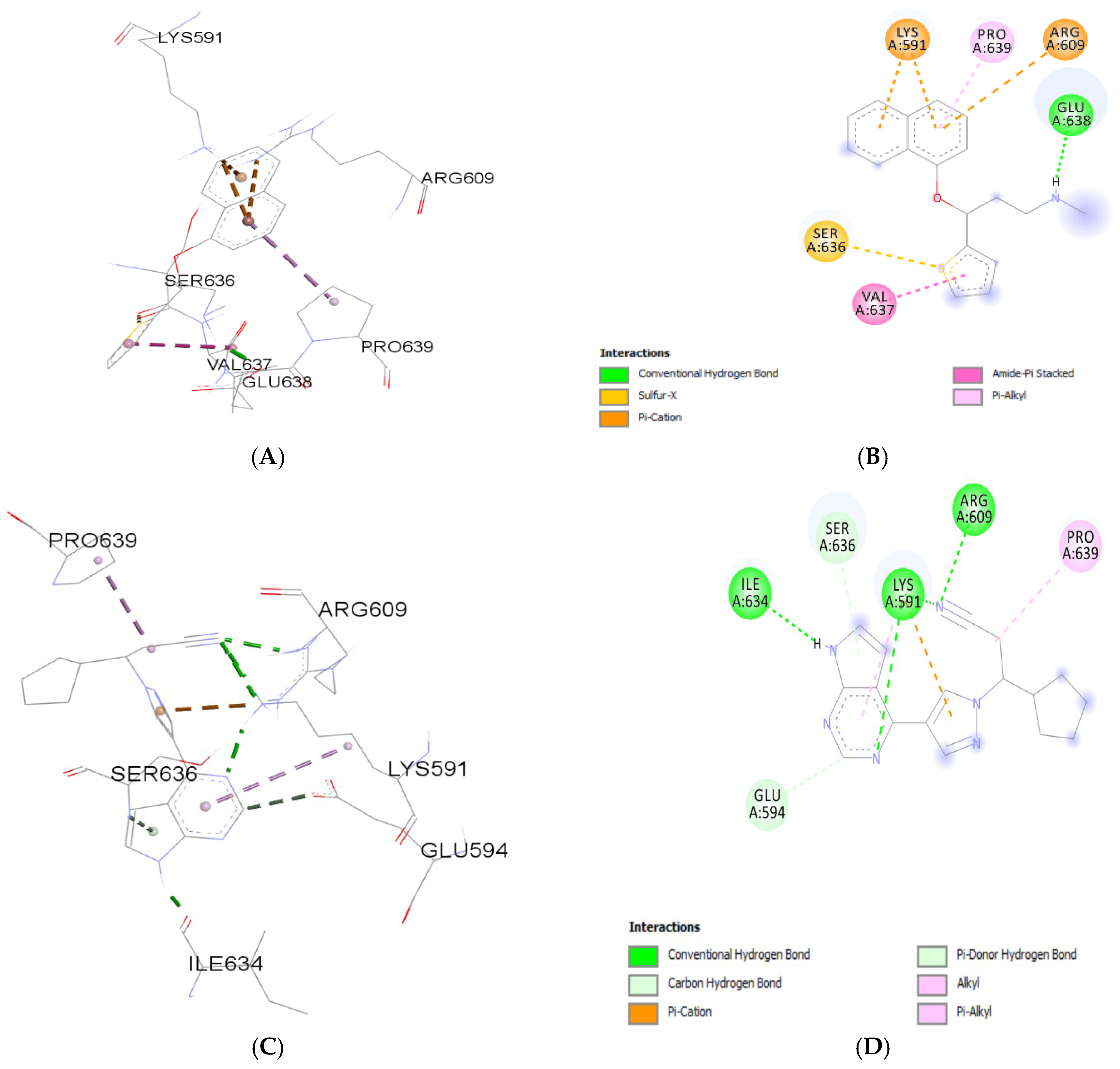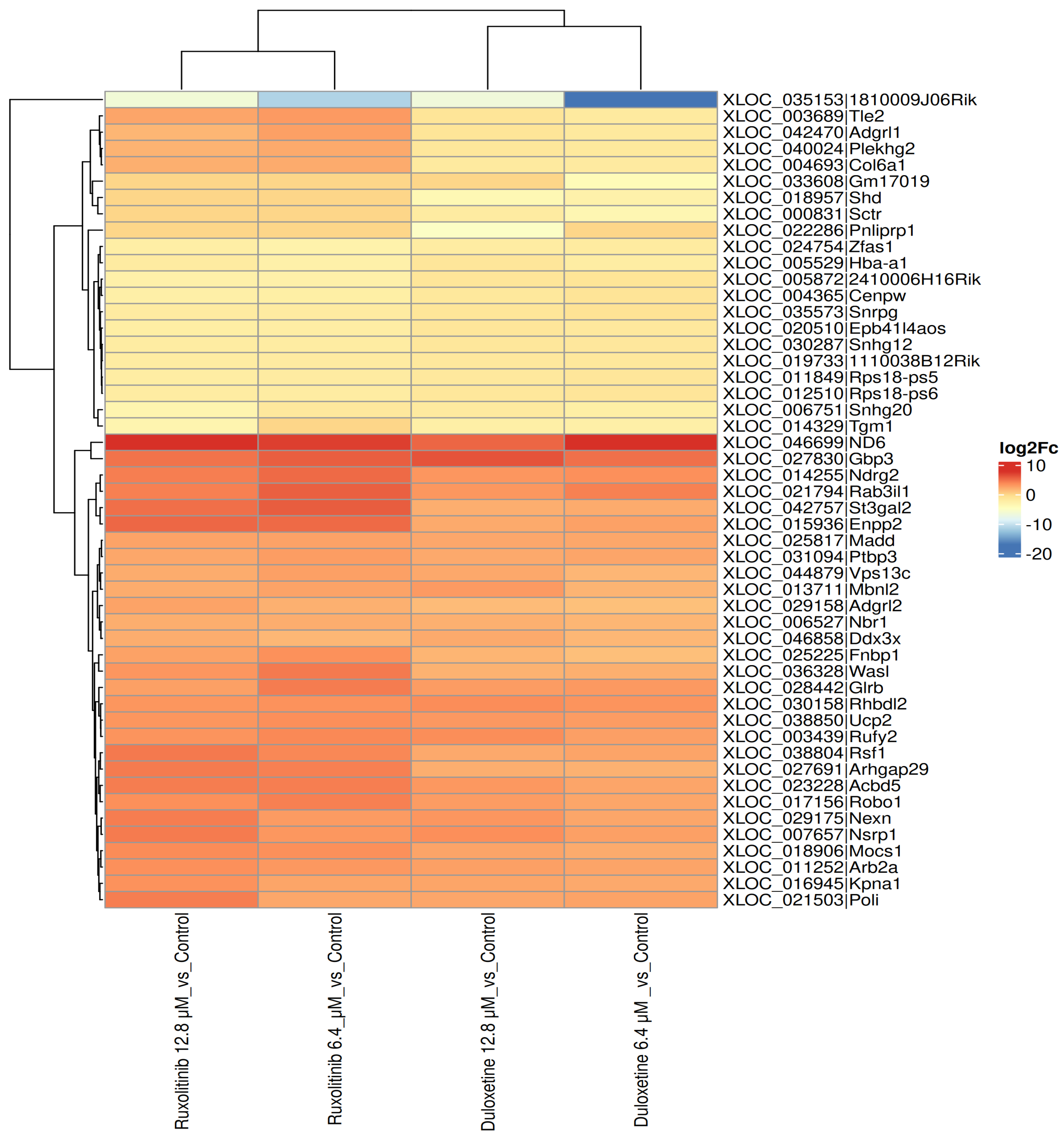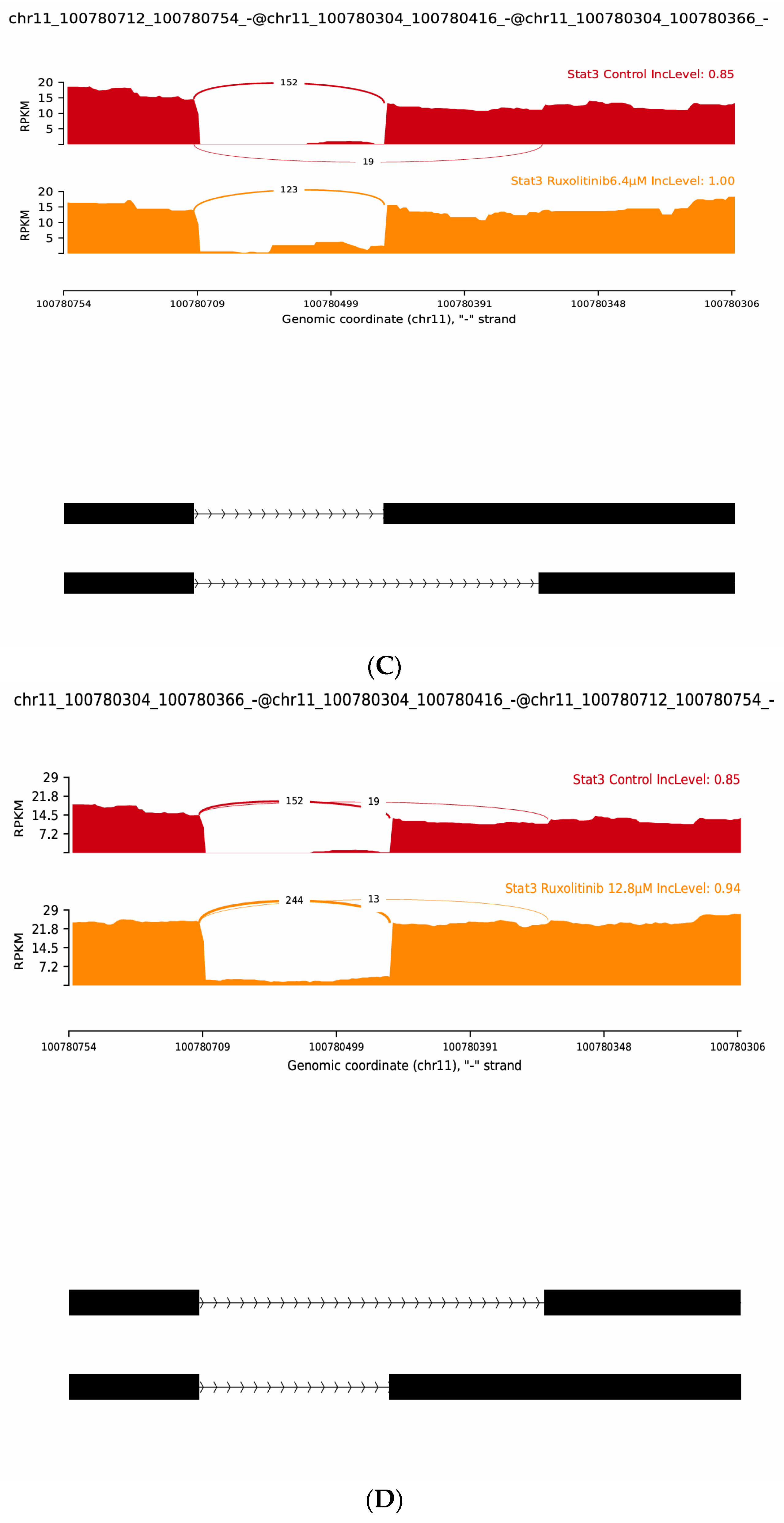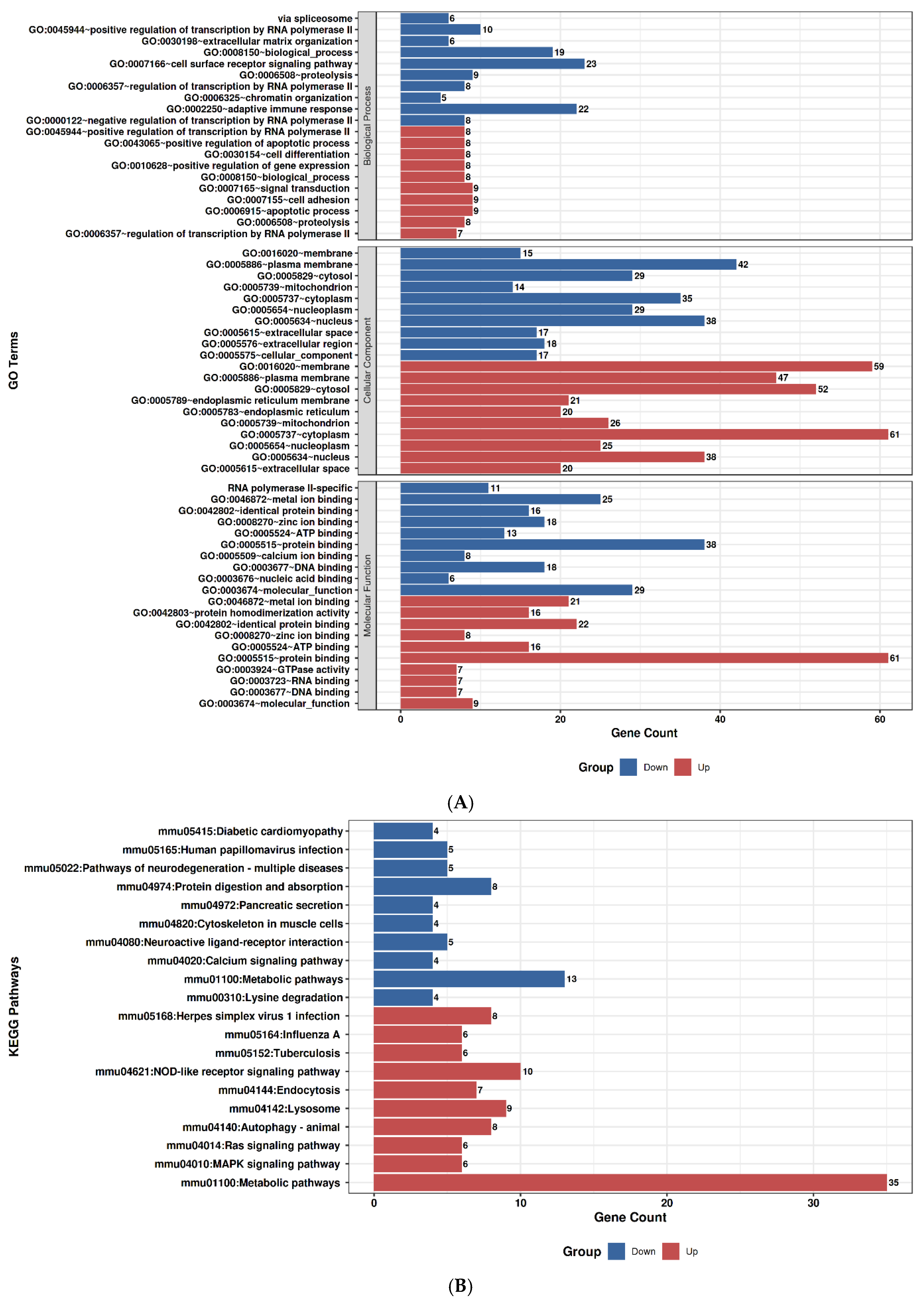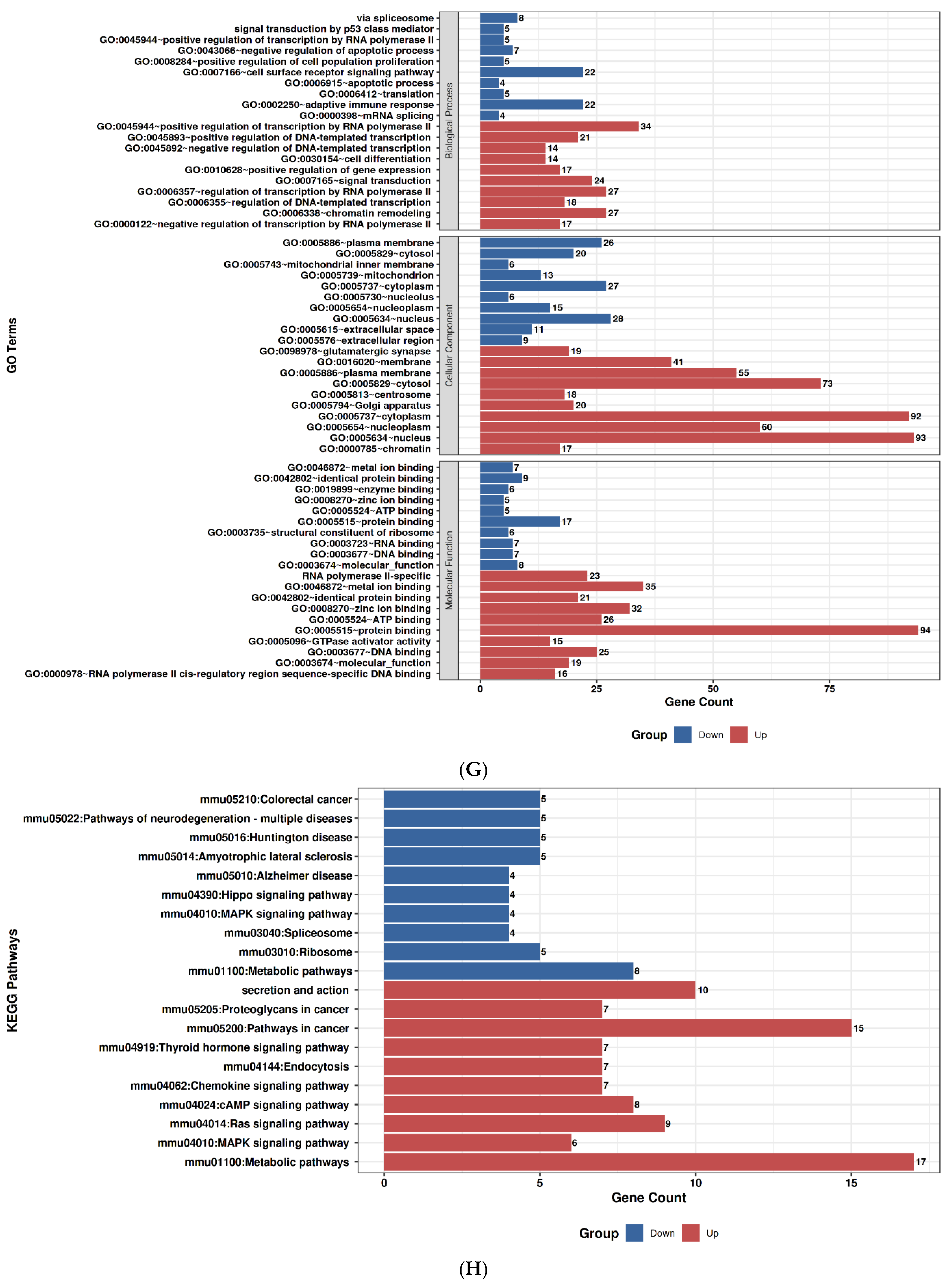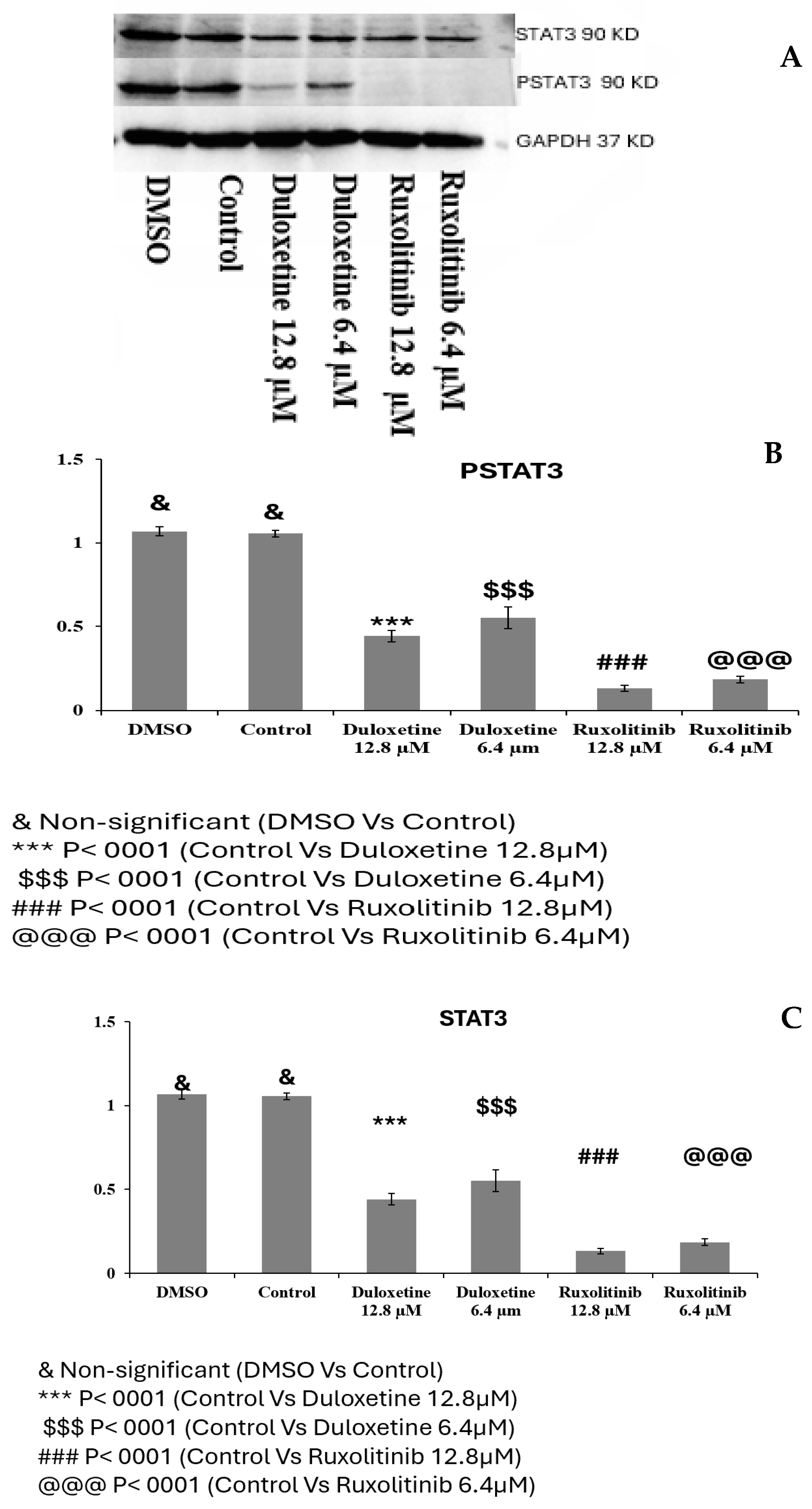1. Introduction
Chronic pain is a prevalent, polyetiological illness that burdens patients and healthcare systems worldwide on a physical, emotional, and societal level. Conventional analgesic can work well in chronic and neuropathic pain syndromes but possess adverse effects such as gastrointestinal ulcerations and bleeds, renal insufficiency, and respiratory depression [
1,
2,
3]. This often compels doctors towards seeking alternative treatment options, especially in case of comorbid illness in an elderly patient or late-life depression. Amongst newer options, Duloxetine, a serotonin and norepinephrine reuptake inhibitor (SNRI), has demonstrated clinical efficacy not only in mood disorders but also in pain syndromes that are chronic, such as diabetic peripheral neuropathy, fibromyalgia, and chronic musculoskeletal pain [
1,
2,
3]. Apart from this traditional mechanism of action of SNRI, pleiotropic activity of Duloxetine implies that its analgesic activity is not necessarily attributable to monoamine modulation but could be attributable to other molecular targets.
Studies have reported the Janus kinase 2–signal transducer and activator of transcription 3 (JAK2/STAT3) pathway as a mediator of chronic pain development and maintenance [
4,
5]. Activation of STAT3, as pSTAT3, triggers gene expression that produces inflammation, neuronal plasticity, and glial activation that result in pain hypersensitivity and central sensitization [
6,
7,
8,
9,
10]. Aberrant activation of pSTAT3 has been observed in spinal glial cells and neurons in neuropathic and inflammatory conditions; therefore, it is an attractive therapeutic target [
8]. Abnormal and recurrent pSTAT3 activation has been documented in spinal microglia and astrocytes, precipitating the release of pro-inflammatory mediators. In rodent models of inflammatory and neuropathic pain, STAT3 phosphorylation blockade decreases mechanical allodynia and thermal hyperalgesia substantially, which proves its pivotal role in maintaining chronic pain states. Inhibition of such a pathway, therefore, has promising therapeutic potential for refractory and chronic pain syndromes [
4,
8]. To investigate Duloxetine’s potential effects on STAT3 signaling, we used an integrative approach combining
In-silico molecular docking and dynamics simulations with
In-vitro experimental validation [
11].
To strengthen mechanistic understanding, we compared Duloxetine with Ruxolitinib, a clinically established JAK1/2 inhibitor known to suppress STAT3 phosphorylation [
12]. This
In-vitro analyses revealed that Duloxetine reduced pSTAT3 levels in a manner comparable to Ruxolitinib, suggesting that Duloxetine’s inhibitory effect on STAT3 may be functionally significant and therapeutically relevant. This comparison highlights Duloxetine’s potential as a dual-action agent, providing both central neurotransmitter modulation and peripheral inhibition of STAT3-mediated inflammatory signaling. The ability of Duloxetine to mimic aspects of a canonical STAT3 inhibitor underscores its value as a repurposable drug with pleiotropic therapeutic effects in chronic pain management. This study aims to elucidate the pleiotropic mechanisms of Duloxetine, with particular focus on its analgesic effects mediated through pSTAT3 inhibition, so that rationale for its prescription can be better understood, optimized, and broadened to include patients with pain, cognitive impairment, and late-life depression.
2. Results
2.1. pSTAT3 Molecular Interaction Analyses of Duloxetine and Ruxolitinib
Molecular docking analyses revealed that both Duloxetine and Ruxolitinib established stable interactions within the pSTAT3 binding pocket, but with distinct interaction profiles. Duloxetine formed a conventional hydrogen bond with GLU204, along with Pi–Pi stacking interactions with TYR176 and several Pi–alkyl contacts (LEU179, LYS180, MET200, LEU203, LEU207), indicating a balance of polar and hydrophobic stabilization. In contrast, Ruxolitinib displayed a broader hydrophobic network, characterized by carbon–hydrogen bonding with TYR176, Pi–sulfur interaction with MET200, and multiple alkyl/Pi–alkyl contacts with LEU179, LYS180, and LEU203. Binding energy of Duloxetine with PSTAT3 was −5.83 kcal/mol. Ruxolitinib demonstrated a more extensive hydrophobic stabilization pattern, consistent with its established potency as a JAK/STAT pathway inhibitor. Duloxetine, although not optimized as Ruxolitinib, showed a notable ability to occupy pSTAT3 active site, suggesting a potential modulatory effect on STAT3 signaling in addition to its known pharmacological actions. Binding energy of Ruxolitinib with pSTAT3 was −6.19 kcal/mol.
Both ligands target overlapping residues (TYR176, LEU179, LYS180, MET200, LEU203), but interaction chemistry differs. Duloxetine introduces more polar stabilization (H-bond with GLU204), while Ruxolitinib relies on stronger hydrophobic and sulfur-based contacts, supporting its tighter binding.
Figure 1 represents the molecular interaction of Duloxetine and Ruxolitinib.
2.2. STAT3 Molecular Interaction Analyses with Duloxetine
Molecular interaction analyses revealed distinct binding profiles of Duloxetine and Ruxolitinib with STAT3. Duloxetine primarily engaged residues LYS591, ARG609, SER636, PRO639, VAL637, and GLU638. Its binding was stabilized by one conventional hydrogen bond with GLU638, in addition to Pi–cation (LYS591, ARG609), Pi–alkyl (PRO 639), and amide–Pi stacking (VAL 637) interactions. These findings suggest that Duloxetine stabilizes STAT3 through a combination of polar and aromatic interactions. Binding energy of Duloxetine with STAT3 was −5.24 kcal/mol.
In contrast, Ruxolitinib demonstrated stronger polar interactions by forming conventional hydrogen bonds with ILE634, ARG 609, and LYS 591 and carbon hydrogen bond with SER636 and GLU594. It also showed Pi–cation interaction with LYS591 and hydrophobic (alkyl/Pi–alkyl) interactions with surrounding residues PRO639 (
Figure 2). Binding energy of Ruxolitinib with STAT3 was −6.06 kcal/mol. This indicates that Ruxolitinib engages STAT3 through a hydrogen-bond–dominant binding pattern, which may contribute to stronger affinity compared to Duloxetine.
Table 1 provides details about molecular interaction.
2.3. MD Simulation Analyses with Duloxetine and Ruxolitinib
MD simulations were conducted to assess the dynamic stability of STAT3 and pSTAT3 complexes with Duloxetine and Ruxolitinib. Root mean square deviation (RMSD) profiles demonstrated that both STAT3 and pSTAT3 complexes achieved equilibrium during simulation, with fluctuations remaining within a narrow range. Notably, STAT3–Ruxolitinib and pSTAT3–Ruxolitinib exhibited lower RMSD deviations compared to Duloxetine complexes, indicating a more stable conformation of protein–ligand complexes. Solvent Accessible Surface Area (SASA) values remained consistent across the trajectory for both STAT3 and pSTAT3. However, Ruxolitinib-bound forms displayed slightly reduced solvent exposure, suggesting a more compact structural arrangement relative to Duloxetine-bound complexes. Root mean square fluctuation (RMSF) analyses revealed that the binding of both ligands reduced local flexibility of STAT3 and pSTAT3. Furthermore, Ruxolitinib provided stronger stabilization by minimizing residue fluctuations more effectively than Duloxetine.
Radius of Gyration (Rg) values for all complexes were stable within the range of ~3.35–3.45 nm. Both STAT3–Ruxolitinib and pSTAT3–Ruxolitinib consistently maintained marginally lower Rg values, supporting more compact structures. Finally, hydrogen bond analyses highlighted a marked difference: Ruxolitinib formed a greater number of persistent hydrogen bonds with both STAT3 and pSTAT3 throughout 10 ns trajectory, whereas Duloxetine interactions were fewer and more transient,
Figure 3.
Overall, MD results confirm that Ruxolitinib stabilizes STAT3 and pSTAT3 more effectively than Duloxetine, as reflected by lower RMSD, reduced solvent exposure, enhanced rigidity, and stronger hydrogen-bonding interactions.
Table 2 provides details of the MD simulation.
2.4. Molecular Mechanics Poisson–Boltzmann Surface Area (MM-PBSA) Analyses for pSTAT3 and STAT3 with Duloxetine and Ruxolitinib
MM-PBSA calculations were carried out to compute the binding free energies of Duloxetine and Ruxolitinib with both phosphorylated STAT3 (pSTAT3) and non-phosphorylated STAT3 (STAT3). Results are summarized in
Table 3.
For pSTAT3 complexes, Duloxetine showed a slightly more favorable total binding free energy (ΔG = −15.17 kJ·mol−1) than Ruxolitinib (ΔG = −12.98 kJ·mol−1). In both cases, van der Waals interactions were the major favorable contributors (−20.29 and −26.27 kJ·mol−1, respectively). Ruxolitinib had a stronger electrostatic component (ΔEEL = −14.61 kJ·mol−1 vs. −19.16 kJ·mol−1 for Duloxetine), but this advantage was offset by a larger unfavorable solvation energy (ΔGSOLV = +27.89 kJ·mol−1).
In contrast, for STAT3 complexes, Duloxetine formed an unfavorable binding free energy (ΔG = +9.78 kJ·mol−1), whereas Ruxolitinib maintained weak but favorable binding (ΔG = −6.39 kJ·mol−1). However, Ruxolitinib and Duloxetine both showed strong van der Waals and electrostatic interactions (ΔEvdW = −23.54 to −19.84 kJ·mol−1; ΔEEL = −22.18 to −40.98 kJ·mol−1). These contributions were outweighed by highly unfavorable solvation energies (ΔGSOLV = +55.51 and +54.44 kJ·mol−1 for Duloxetine and Ruxolitinib, respectively). This suggests that solvation penalties significantly reduce the binding affinity of both ligands to unphosphorylated STAT3.
Overall, these findings suggest that both Duloxetine and Ruxolitinib bind more favorably to phosphorylated STAT3 compared with non-phosphorylated STAT3, with Duloxetine exhibiting the most stable interaction among the tested complexes.
2.5. C2C12 Cell Culture and MTT Assay
C2C12 murine myoblasts grew normally under standard culture conditions, displaying typical spindle-shaped morphology and reaching ~70–80% confluency before experimental treatment. MTT assay demonstrated a concentration-dependent reduction in cell viability following exposure to Duloxetine and Ruxolitinib. At lower concentrations (0.2–3.2 µM), both drugs caused minimal cytotoxicity. At highest tested concentration (12.8 µM), Duloxetine-treated cells maintained ~80–90% viability, whereas Ruxolitinib-treated cells showed reduced viability of ~70–80% relative to untreated controls. Figures are provided in
Supplementary File.
These findings indicate that both Duloxetine and Ruxolitinib modestly reduce C2C12 cell viability, with Ruxolitinib exerting a comparatively stronger inhibitory effect at higher concentrations. MTT assay results are presented in
Supplementary File.
2.6. Transcriptomic Clustering of Duloxetine and Ruxolitinib
Analysis of STAT3 (XLOC_008057; chr11:100777631–100861443) expression across treatment groups showed that Ruxolitinib at 12.8 μM (log2FC = 0.38) and 6.4 μM (log2FC = 0.71) did not alter STAT3 expression compared with control. Likewise, Duloxetine at 6.4 μM (log2FC = −0.20) and 12.8 μM (log2FC = −0.04) had no significant effect. Findings show that STAT3 transcript abundance remains constant under all treatment conditions, indicating that post-transcriptional or post-translational mechanisms, such as phosphorylation-dependent activation, may be involved rather than transcriptional modulation of STAT3 in action of Ruxolitinib and Duloxetine. These findings confirm Duloxetine phosphorylation inhibitory potential reported by other studies [
13]. A volcano plot of different treatment conditions is provided in
Supplementary File.
Hierarchical clustering and heatmap analysis of differentially expressed transcripts demonstrated distinct gene expression profiles following IL6 treatment combined with Duloxetine or Ruxolitinib at two different concentrations (12.8 μM and 6.4 μM). Findings demonstrate two major gene clusters. First and larger cluster contained transcripts that were upregulated (depicted in orange red), and this induction was consistent across both drugs, indicating a broadly shared transcriptional activation program. Upregulated genes included stress-response and signaling regulators such as Ndrg2, Enpp2, Madd, Ucp2, Robo1, and Rbbdl2. The second cluster contained a smaller group of transcripts strongly downregulated after treatment, particularly in Ruxolitinib-exposed cells, as shown in blue shading. Representative suppressed genes included Tle2, Adgrl1, Plekhg2, Col6a1, Shd, and Scr.
Interestingly, samples treated with varying dosages of Ruxolitinib and Duloxetine grouped together, indicating that the transcriptional effects of both drugs are dose consistent. Inter-drug comparison showed that groups treated with Ruxolitinib formed a separate branch from groups treated with Duloxetine, indicating compound-specific variations in gene regulation. However, combined data show that whereas both medications significantly reprogram transcription when used in conjunction with IL6, Duloxetine mainly increases gene activation, while Ruxolitinib induces a higher suppressive response. Ruxolitinib’s stronger suppressive action may account for its effectiveness in treating resistant graft-vs-host disease (GVHD), polycythemia vera, and myelofibrosis,
Figure 4.
2.7. Heatmap Analysis of STAT3 Isoforms Across Duloxetine and Ruxolitinib Treatments
Heatmap analysis of STAT3 isoforms revealed distinct, dose-dependent expression patterns across treatment groups. Canonical isoforms showed relatively stable expression under both Duloxetine and Ruxolitinib treatments, indicating that baseline STAT3 transcription remains largely unchanged. In contrast, several novel isoforms, annotated with class code “j”, exhibited pronounced differential regulation, emphasizing impact of alternative splicing in response to pharmacological intervention.
For Duloxetine, lower dose (6.4 µM) produced modest changes in isoform expression, with select novel isoforms showing slight up or downregulation. At higher dose (12.8 µM), several novel isoforms were found to be upregulated, suggesting that increased drug exposure promotes transcript diversity and selectively enhances specific splice variants. Similarly, Ruxolitinib demonstrated dose-dependent modulation of STAT3 isoforms: Ruxolitinib at 6.4 µM dose elicited minor changes in novel isoforms, while at 12.8 µM dose, it induced stronger differential regulation, with certain novel transcripts significantly upregulated, indicating that JAK-STAT pathway inhibition can influence STAT3 splicing in a dose-specific manner.
Overall, these results show that the expression of the STAT3 isoform is modulated in a dose-dependent pattern by both Duloxetine and Ruxolitinib, with novel transcripts contributing substantially to observed variability (
Table 4). These patterns suggest that pharmacological interventions can differentially influence STAT3 transcript diversity, potentially impacting downstream signaling and functional cellular responses,
Figure 5.
2.8. Replicate Multivariate Analysis of Transcript Splicing (rMATSv4.30) Junction Analysis of STAT3 Isoforms Across Duloxetine and Ruxolitinib Treatments
Splicing analyses further demonstrated distinct treatment-dependent effects. In the case of Duloxetine, splicing modulation was subtle across the chr11:100780712–100784112 region. Control samples exhibited an IncLevel of 0.90, which decreased slightly to 0.80 under Duloxetine 6.4 µM but returned close to baseline (0.86) under Duloxetine 12.8 µM, suggesting mild and reversible effects on exon usage. In event spanning chr11:100780712–100780754 and downstream exons at chr11:100780304–100780366/416, control samples showed substantial exon inclusion (IncLevel 0.85), whereas Ruxolitinib at 6.4 µM resulted in complete inclusion (IncLevel 1.00), suggesting enhanced splicing fidelity. For event linking chr11:100780712–100780754 to chr11:100783900–100784112, control samples again showed strong inclusion (IncLevel 0.90), but Ruxolitinib at 12.8 µM reduced inclusion to 0.94, indicating a dose-dependent suppression of exon incorporation.
Overall, rMATS junction analyses validate heatmap findings by demonstrating that both Duloxetine and Ruxolitinib reshape STAT3 isoform diversity in a dose-dependent manner. While Duloxetine induces modest exon skipping at low concentrations and enhanced inclusion of novel variants at higher doses, Ruxolitinib exerts a stronger and more uniform effect, driving increased inclusion across multiple splice junctions. These findings emphasize role of novel “j” isoforms as key contributors to STAT3 variability and suggest that drug-induced alternative splicing may act as an additional regulatory mechanism with significant consequences for STAT3-mediated signaling,
Figure 6.
2.9. GO and Pathway Enrichment Profiles of Duloxetine and Ruxolitinib
To explore the molecular impact of Duloxetine and Ruxolitinib at two concentrations (6.4 µM and 12.8 µM), we performed Gene Ontology (GO) enrichment and KEGG pathway analyses in comparison with untreated controls. Duloxetine treatment at 6.4 µM was associated with significant enrichment of pathways related to mitochondrial activity, oxidative phosphorylation, and protein quality control. Notably, GO categories highlighted alterations in cellular respiration and electron transport chain activity, while KEGG pathways emphasized modulation of neuroactive ligand–receptor interactions and metabolic signaling. At the higher concentration of 12.8 µM, the impact of Duloxetine became more extensive, with enrichment of processes involved in apoptotic signaling, unfolded protein response, and transcriptional regulation. Importantly, KEGG analysis at this dose revealed activation of MAPK and calcium signaling pathways as well as synaptic regulatory mechanisms, suggesting a dose-dependent shift toward stress-responsive and signaling networks.
In contrast, Ruxolitinib demonstrated a distinct enrichment pattern consistent with its known pharmacological actions. At 6.4 µM, it prominently affected cytokine-mediated signaling, immune regulation, and JAK–STAT–associated processes. KEGG analysis further underscored significant involvement of cytokine–cytokine receptor interactions and JAK–STAT signaling. Increasing dose to 12.8 µM amplified these effects and extended enrichment profile to include inflammatory responses, apoptotic regulation, and cell cycle control. Correspondingly, KEGG pathways at this concentration highlighted PI3K–Akt signaling, p53 pathway, and additional immune-related signaling cascades, indicating broader immunomodulatory and stress-regulatory effects at higher drug exposure.
Taken together, comparative analyses showed that Duloxetine predominantly modulated neuronal, mitochondrial, and metabolic pathways, whereas Ruxolitinib targeted immune and cytokine-driven networks. Both drugs exhibited clear dose-dependent effects, with higher concentrations leading to engagement of apoptosis, transcriptional regulation, and cell cycle control. Nevertheless, overlap between Duloxetine- and Ruxolitinib-associated pathways was minimal, underscoring distinct mechanistic profiles: Duloxetine exerted its influence primarily through neuro-metabolic and stress-related signaling, while Ruxolitinib acted chiefly through immunomodulatory and cytokine-regulated pathways,
Figure 7.
2.10. Duloxetine Suppresses Il-6–Induced STAT3 Phosphorylation in C2C12 Cells
In both pSTAT3 and STAT3 expression analyses, treatment with Duloxetine and Ruxolitinib led to a marked reduction compared to control groups. DMSO did not cause any significant change when compared with control, confirming that the solvent had no effect on protein expression. pSTAT3 and STAT3 levels were significantly reduced by Duloxetine administration at 12.8 µM (
p < 0.0001), and while a substantial suppression was also observed at 6.4 µM (
p < 0.0001), the effect was a bit smaller, suggesting a dose-dependent inhibition. Similarly, Ruxolitinib treatment at both 12.8 µM and 6.4 µM caused a profound reduction in pSTAT3 and STAT3 expression (
p < 0.0001). Notably, Ruxolitinib exhibited a stronger inhibitory effect in comparison with Duloxetine at corresponding concentrations, with most prominent reduction observed at 12.8 µM. Overall, these results demonstrate that both Duloxetine and Ruxolitinib effectively inhibit total STAT3 and its phosphorylated form, with Ruxolitinib exerting a more potent suppressive effect compared to Duloxetine,
Figure 8. Raw files of Western blot are provided in the
Supplementary File.
3. Discussion
This study provides integrative
In-silico and
In-vitro evidence that Duloxetine, an SNRI widely used to treat depressive disorder and for chronic pain, exerts a pleiotropic mechanism of action by directly targeting phosphorylated STAT3 (pSTAT3) signaling in addition to its canonical role in neurotransmitter reuptake inhibition. By combining molecular docking, molecular dynamics (MD) simulations, MM-PBSA binding energy estimations, cellular assays, and transcriptomic profiling, we establish Duloxetine as a dual-function therapeutic agent with potential advantages over selective JAK/STAT inhibitors such as Ruxolitinib [
13]. However, earlier Duloxetine efficacy to prevent activation of p38 phosphorylation has been reported [
13]. Our docking studies demonstrated that Duloxetine binds stably within pSTAT3 pocket through a combination of hydrogen bond (notably GLU204) and hydrophobic interactions, although its binding profile is different from Ruxolitinib, which relied more extensively on hydrophobic stabilization. Additionally, common interacting residues for STAT3 was LYS 591, which stabilized with Pi-cation LYS 591.
MD simulations further confirmed that both drugs achieve equilibrium with pSTAT3, STAT3, but Ruxolitinib produced a more compact and stable protein–ligand complex with lower RMSD and higher hydrogen bond persistence. Nonetheless, MM-PBSA free energy analyses revealed that Duloxetine exhibits more favorable binding to pSTAT3 (ΔG = −15.17 kJ·mol−1) than Ruxolitinib (ΔG = −12.98 kJ·mol−1). This suggests that Duloxetine selectively stabilizes interactions with activated STAT3, providing a potential mechanism for targeted inhibition of pathological STAT3 signaling.
In-vitro, Duloxetine efficiently and dose-dependently prevented phosphorylation of STAT3 in C2C12 cells caused by IL-6. Duloxetine significantly reduced pSTAT3 levels in Western blot at both 6.4 µM and 12.8 µM, although it has been observed that Ruxolitinib had strong inhibitory impact at same dose. Furthermore, MTT viability assays revealed that Duloxetine maintained higher cell survival (~80–90% at 12.8 µM) compared with Ruxolitinib (~70–80%), indicating that Duloxetine achieves STAT3 suppression with less cytotoxicity. This balance between efficacy and cellular safety highlights a key translational benefit of Duloxetine over more potent but less tolerable JAK/STAT inhibitors.
In addition, RNA sequencing uncovered drug specific gene expression programs. Duloxetine appears to modulate mitochondrial function, oxidative phosphorylation, metabolic pathways, and synaptic signaling, suggesting a potential link between its effects and neuroenergetic and stress-response processes. Specifically, long treatment with Duloxetine has been shown to influence mitochondrial dynamics and energy metabolism in neural tissues [
13,
14,
15,
16]. Additionally, the antidepressant Fluoxetine’s impact on synaptic signaling pathways and mitochondrial features has been observed in a previous study [
17]. While direct evidence of Duloxetine’s interaction with STAT3 is limited, its modulation of related pathways, such as the IL-6 signaling pathway, suggests a potential involvement in the JAK/STAT3 pathway [
2,
13]. Furthermore, Duloxetine’s effects on oxidative stress and apoptosis [
2,
13,
16,
18], as well as its influence on neuroplasticity and synaptic signaling [
2,
13,
18], support the hypothesis that Duloxetine may enhance neuroenergetic and stress-response processes through mechanisms that could involve STAT3 signaling. Ruxolitinib predominantly suppressed immune- and cytokine-related signaling, consistent with its pharmacological role as a JAK1/2 inhibitor [
12,
19]. Heatmap and clustering analyses confirmed these distinct signatures: Duloxetine promoted gene activation and stress-response regulators (e.g., Ndrg2, Ucp2), while Ruxolitinib induced stronger downregulation of structural and regulatory genes (e.g., Tle2, Col6a1).
A novel finding of this study is the isoform-level regulation of STAT3. Duloxetine promoted transcript diversity, particularly at higher concentrations, by enhancing the expression of several novel splice variants, notably the “j” class, consistent with reports that antidepressants can modulate alternative splicing [
20,
21]. In contrast, Ruxolitinib induced more pronounced exon inclusion events, as revealed by rMATS junction analysis, promoting splicing fidelity while limiting transcript diversity. These observations suggest that both Duloxetine and Ruxolitinib reshape STAT3 signaling not only through inhibition of phosphorylation but also via modulation of alternative splicing. Notably, Duloxetine appears to favor isoform diversification, potentially broadening its regulatory influence on downstream signaling pathways, whereas Ruxolitinib may reinforce specific splicing patterns, leading to more constrained functional outcomes.
Collectively, these findings offer a theory in which Duloxetine couples its classical role as an SNRI with direct suppression of pSTAT3 activation and regulation of STAT3 transcript diversity. Duloxetine exerts its effects through interconnected pathways involving neurotransmission, mitochondrial metabolism, and stress-response regulation, which may underline its sustained clinical efficacy in chronic pain syndromes with both neuropathic and inflammatory components. Furthermore, its favorable balance of efficacy and cell viability suggests a wider therapeutic window compared to selective JAK inhibitors. Future studies should extend validation to neuronal and glial cell types, as well as in vivo models of chronic pain. Moreover, while RNA-seq revealed robust isoform-level regulation, functional characterization of these novel STAT3 splice variants is important to determine its specific roles in signaling and pain modulation.

